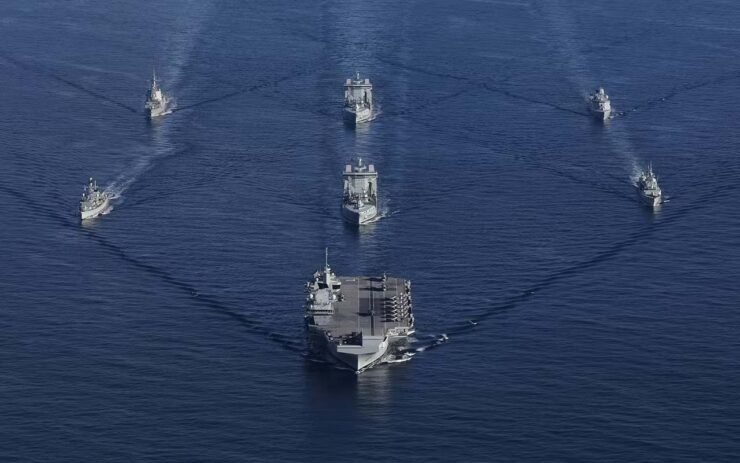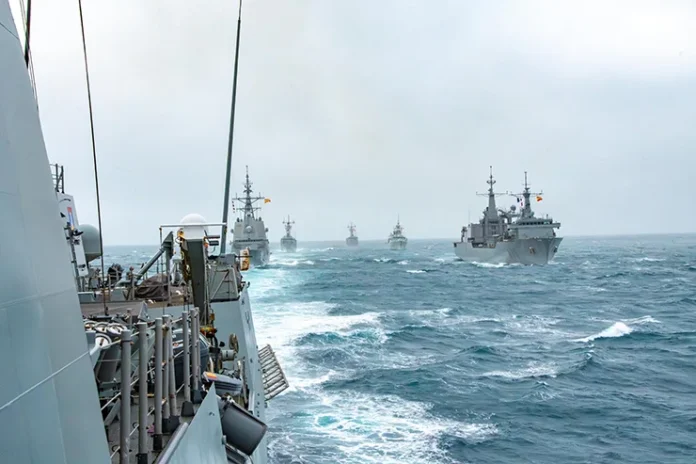Steadfast Defender 24 (STDE24) – a large-scale military exercise being conducted from January 22nd to May 31st, 2024 in several countries, including Finland, Estonia, Germany, Greece, Hungary, Latvia, Lithuania, Norway, Poland, Romania, Slovakia, Sweden, and the United Kingdom marks a pivotal moment in NATO’s history. It is the largest NATO exercise since World War II, involving over 90,000 troops from all 31 NATO Allies and Sweden. It demonstrates the unbreakable bond between NATO Allies over the past 75 years.
In all over 1,100+ combat vehicles including more than 150 tanks, 500 infantry fighting vehicles and 400 armoured personnel carriers, 80+ air platforms including F-35s, FA-18s, Harriers, F-15s, helicopters and myriad unmanned aerial vehicles and 50+ naval assets including aircraft carriers, destroyers, frigates and corvettes will participate in the multi-domain exercise, incorporating land, air, sea, cyber, and space operations across thousands of kilometres.
The idea behind all this is to demonstrate the alliance’s ability to defend every inch of NATO territory and as well as conduct and sustain complex multi-domain operations, over several months across thousands of kilometres from the high north to central and Eastern Europe.
Steadfast Defender 2024’s purpose is to display NATO’s strength, adaptability, and commitment to defending its members. However, STDE24’s significance goes beyond the immediate display of military prowess. It marks a turning point for NATO, signifying a renewed commitment to collective defence and adaptation in the face of a complex and ever-evolving security landscape
Steadfast Defender 2024’s primary purpose is to display NATO’s collective strength, adaptability, and unwavering commitment to defending its members in a rapidly evolving security landscape. Steadfast Defender is the largest exercise since Reforger exercise in 1988 and the first large-scale test of alliance defence plans approved at last year’s Vilnius Summit in Lithuania.
However, STDE24’s significance goes beyond the immediate display of military prowess. It marks a turning point for NATO, signifying a renewed commitment to collective defence and adaptation in the face of a complex and ever-evolving security landscape.
STDE24 – Goals
- Test and refine NATO’s defence plans for reinforcing European defences.
- Demonstrate the Alliance’s ability to rapidly deploy forces from North America and other parts of the
Alliance to Europe.
- Enhance civil-military cooperation and national and collective resilience.
- Showcase NATO’s transatlantic unity, strength, and determination to protect its members and shared values.
Activities
- Multi-domain operations encompassing land, air, sea, cyber, and space.
- Deployment of forces from North America to Europe.
- Complex exercises across thousands of kilometers, from the High North to Central and Eastern Europe.
Exercise Steadfast Defender 24- timeline
Exercise Steadfast Defender 24 is split into two overlapping parts. Each phase of the exercise includes a range of associated exercises hosted by different countries.
Part 1 focuses on transatlantic reinforcement – the strategic deployment of North American forces across the Atlantic to continental Europe. This phase includes maritime live exercises and amphibious assault training in the North Atlantic and Arctic seas.

Part 2 focuses on multi-domain exercises across Europe – demonstrating NATO, national and multinational military capabilities. This phase will also test the rapid deployment of troops and equipment across borders within the Alliance.
During the initial phase (End of January to mid-March), the focus will be on maritime reinforcement across the Atlantic and in the Arctic. The second phase (mid-February to the end of May) will shift to using deployed reinforcements across all domains, from the Arctic to the Eastern Flank.
The Genesis of Steadfast Defender 24
The seeds of STDE24 were sown amidst a backdrop of heightened geopolitical tensions. Russia’s annexation of Crimea in 2014 and its assertive actions in the Black and Baltic Seas served as stark reminders of the potential threats faced by NATO members. Additionally, the rise of China and the evolving nature of warfare, with an increased focus on cyber and hybrid threats, necessitated a re-evaluation of NATO’s defence posture.
Recognising these challenges, NATO leaders pledged to enhance the Alliance’s readiness and responsiveness during the 2016 Warsaw Summit. STDE24 emerged as a concrete manifestation of this commitment, aiming to test and refine NATO’s collective defence plans and demonstrate its ability to effectively deter and, if necessary, defend against potential aggression.
Steadfast Defender 24: Significance and Lasting Impact
The exercise serves as a powerful deterrent against potential adversaries, demonstrating NATO’s resolve and capability to defend its members. It also highlights the Alliance’s ability to learn and adapt, incorporating lessons learned from recent events and technological advancements into its defence strategies.
Furthermore, STDE24 fosters closer cooperation and interoperability between NATO members and partner nations. This enhanced collaboration strengthens the Alliance’s overall effectiveness and lays the groundwork for future joint operations. The exercise also serves as a valuable opportunity to test and refine critical defence plans, ensuring NATO’s preparedness for potential future contingencies.
The seeds of STDE24 were sown amidst a backdrop of heightened geopolitical tensions. Russia’s assertive actions in the Black and Baltic Seas as well as the rise of China with an increased focus on cyber and hybrid threats served as stark reminders of the need to refine NATO’s collective defense plans and effectively deter and, if necessary, defend against potential aggression
However, STDE24 was not without its critics. Some observers raised concerns about the exercise’s cost and the potential for misinterpretations by Russia, viewing it as a provocative act. Others questioned the effectiveness of such large-scale exercises in the age of modern warfare, emphasising the need to prioritise more agile and adaptable defence strategies.
Looking Forward: The Legacy of STDE24
STDE24’s successful execution serves as a testament to NATO’s enduring relevance and adaptability in the face of an evolving global security landscape. The exercise demonstrated the Alliance’s ability to:
Effectively deter potential adversaries: The sheer scale and complexity of STDE24 sent a clear message to potential aggressors about NATO’s preparedness and resolve to defend its members.
Rapidly deploy and project power: The exercise successfully demonstrated NATO’s ability to swiftly mobilise and deploy significant forces across the Atlantic, showcasing its capacity for decisive action.
Enhance interoperability and collective defence: The exercise fostered closer cooperation and collaboration between member states’ militaries, strengthening NATO’s collective defence posture.
Adapt to emerging threats: The exercise design incorporated various non-traditional threats, reflecting NATO’s recognition of the evolving security
Conclusion
STDE24 marks a significant shift in NATO’s strategic approach. The exercise design reflects an adaptation to the evolving security landscape, characterised by the rise of hybrid threats, cyber warfare, and the increasing assertiveness of strategic competitors. By incorporating these elements into the exercise, NATO seeks to demonstrate its commitment to staying ahead of the curve and prepare for the challenges of the 21st century. More than just a military exercise, Steadfast Defender 24 is a powerful statement of intent. The spirit of unity and cooperation fostered by STDE24 will ensure a safe and more secure future for all its members.
–The writer is a seasoned media professional with over three decades of experience in print, electronic, and web media. He is presently Editor of Taazakhabar News. The views expressed are of the writer and do not necessarily reflect the views of Raksha Anirveda
–The writer is a seasoned media professional with over three decades of experience in print, electronic, and web media. He is presently Editor of Taazakhabar News. The views expressed are of the writer and do not necessarily reflect the views of Raksha Anirveda






